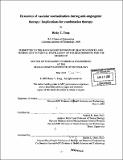| dc.contributor.advisor | Rakesh K. Jain. | en_US |
| dc.contributor.author | Tong, Ricky T. (Ricky Tsee-Wai) | en_US |
| dc.contributor.other | Harvard University--MIT Division of Health Sciences and Technology. | en_US |
| dc.date.accessioned | 2008-02-28T16:13:23Z | |
| dc.date.available | 2008-02-28T16:13:23Z | |
| dc.date.copyright | 2005 | en_US |
| dc.date.issued | 2005 | en_US |
| dc.identifier.uri | http://dspace.mit.edu/handle/1721.1/33076 | en_US |
| dc.identifier.uri | http://hdl.handle.net/1721.1/33076 | |
| dc.description | Thesis (Ph. D.)--Harvard-MIT Division of Health Sciences and Technology, 2005. | en_US |
| dc.description | Includes bibliographical references (leaves 145-155). | en_US |
| dc.description.abstract | Solid tumors require blood vessels for growth, and the goal of anti-angiogenic therapy is to destroy the tumor vasculature. Recent findings suggest that anti-angiogenic therapy enhances radiation and chemotherapy responses. These findings seem paradoxical, since anti-angiogenic therapy prunes tumor vasculature while chemotherapy and radiation therapy rely on the vasculature to transport cancer drugs and oxygen, respectively, to cancer cells. To resolve this paradox, we propose that anti-angiogenic therapy can "normalize" the tumor vasculature transiently, resulting in a more efficient delivery of drugs and oxygen to cancer cells. We first show that DC101, a monoclonal antibody targeting Vascular Endothelial Growth Factor Receptor 2 (VEGFR2), prunes immature blood vessels, reduces vascular diameter and improves pericyte and basement membrane coverages. Functionally, the vascular permeability to macromolecules and interstitial fluid pressure are reduced. By lowering interstitial fluid pressure while maintaining microvascular pressure, DC101 induces a hydrostatic pressure gradient across the vascular wall, which leads to enhanced penetration of macromolecules in tumors. Tumor hypoxia is also reduced, and it is associated with the increased red blood cell velocity after DC101 treatment. Using gene array, real time PCR and Western blot analyses, changes in angiopoietin-2 level during DC101 treatment are identified. To test if similar effects happen in clinical setting, we obtained tumor biopsy samples from rectal adenocarcinoma patients treated with bevacizumab, an anti-VEGF monoclonal antibody. | en_US |
| dc.description.abstract | (cont.) Our analysis shows that after bevacizumab treatment, microvascular density of the tumors decreases while pericyte coverage increases. The level of angiopoietin-2 also decreases, similar to the pre-clinical data. Thus our work shows a potential mechanism that explains the synergism between anti-angiogenic therapy and conventional therapies. These findings should facilitate the design of optimal dose and schedule of anti-angiogenic therapy. | en_US |
| dc.description.statementofresponsibility | by Ricky T. Tong. | en_US |
| dc.format.extent | 167 leaves | en_US |
| dc.language.iso | eng | en_US |
| dc.publisher | Massachusetts Institute of Technology | en_US |
| dc.rights | M.I.T. theses are protected by copyright. They may be viewed from this source for any purpose, but reproduction or distribution in any format is prohibited without written permission. See provided URL for inquiries about permission. | en_US |
| dc.rights.uri | http://dspace.mit.edu/handle/1721.1/33076 | en_US |
| dc.rights.uri | http://dspace.mit.edu/handle/1721.1/7582 | |
| dc.subject | Harvard University--MIT Division of Health Sciences and Technology. | en_US |
| dc.title | Dynamics of vascular normalization during anti-angiogenic therapy : implications for combination therapy | en_US |
| dc.type | Thesis | en_US |
| dc.description.degree | Ph.D. | en_US |
| dc.contributor.department | Harvard University--MIT Division of Health Sciences and Technology | |
| dc.identifier.oclc | 62148229 | en_US |
